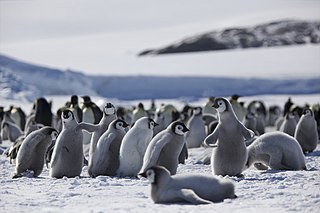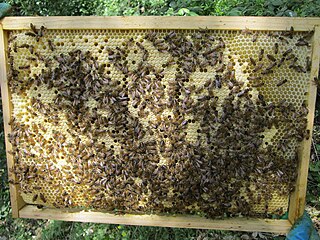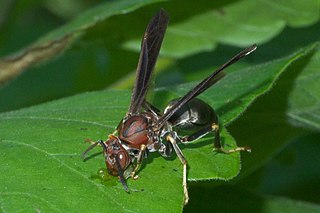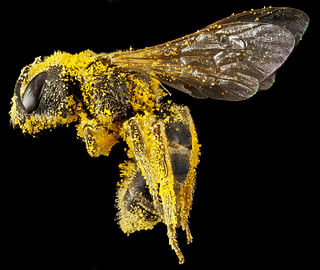
Behavioral ecology, also spelled behavioural ecology, is the study of the evolutionary basis for animal behavior due to ecological pressures. Behavioral ecology emerged from ethology after Niko Tinbergen outlined four questions to address when studying animal behaviors: What are the proximate causes, ontogeny, survival value, and phylogeny of a behavior?

Halictus rubicundus, the orange-legged furrow bee, is a species of sweat bee found throughout the Northern Hemisphere. H. rubicundus entered North America from the Old World during one of two main invasions of Halictus subgenera. These invasions likely occurred via the Bering land bridge at times of low sea level during the Pleistocene epoch.

Lasioglossum malachurum, the sharp-collared furrow bee, is a small European halictid bee. This species is obligately eusocial, with queens and workers, though the differences between the castes are not nearly as extreme as in honey bees. Early taxonomists mistakenly assigned the worker females to a different species from the queens. They are small, shiny, mostly black bees with off-white hair bands at the bases of the abdominal segments. L. malachurum is one of the more extensively studied species in the genus Lasioglossum, also known as sweat bees. Researchers have discovered that the eusocial behavior in colonies of L. malachurum varies significantly dependent upon the region of Europe in which each colony is located.

Reproductive suppression is the prevention or inhibition of reproduction in otherwise healthy adult individuals. It includes delayed sexual maturation (puberty) or inhibition of sexual receptivity, facultatively increased interbirth interval through delayed or inhibited ovulation or spontaneous or induced abortion, abandonment of immature and dependent offspring, mate guarding, selective destruction and worker policing of eggs in some eusocial insects or cooperatively breeding birds, and infanticide, and infanticide in carnivores of the offspring of subordinate females either by directly killing by dominant females or males in mammals or indirectly through the withholding of assistance with infant care in marmosets and some carnivores. The Reproductive Suppression Model argues that "females can optimize their lifetime reproductive success by suppressing reproduction when future conditions for the survival of offspring are likely to be greatly improved over present ones”. When intragroup competition is high it may be beneficial to suppress the reproduction of others, and for subordinate females to suppress their own reproduction until a later time when social competition is reduced. This leads to reproductive skew within a social group, with some individuals having more offspring than others. The cost of reproductive suppression to the individual is lowest at the earliest stages of a reproductive event and reproductive suppression is often easiest to induce at the pre-ovulatory or earliest stages of pregnancy in mammals, and greatest after a birth. Therefore, neuroendocrine cues for assessing reproductive success should evolve to be reliable at early stages in the ovulatory cycle. Reproductive suppression occurs in its most extreme form in eusocial insects such as termites, hornets and bees and the mammalian naked mole rat which depend on a complex division of labor within the group for survival and in which specific genes, epigenetics and other factors are known to determine whether individuals will permanently be unable to breed or able to reach reproductive maturity under particular social conditions, and cooperatively breeding fish, birds and mammals in which a breeding pair depends on helpers whose reproduction is suppressed for the survival of their own offspring. In eusocial and cooperatively breeding animals most non-reproducing helpers engage in kin selection, enhancing their own inclusive fitness by ensuring the survival of offspring they are closely related to. Wolf packs suppress subordinate breeding.

The European paper wasp is one of the most common and well-known species of social wasps in the genus Polistes. Its diet is more diverse than those of most Polistes species—many genera of insects versus mainly caterpillars in other Polistes—giving it superior survivability compared to other wasp species during a shortage of resources.

Bombus bohemicus, also known as the gypsy's cuckoo bumblebee, is a species of socially parasitic cuckoo bumblebee found in most of Europe with the exception of the southern Iberian Peninsula and Iceland. B. bohemicus practices inquilinism, or brood parasitism, of other bumblebee species. B. bohemicus is a generalist parasite, successfully invading several species from genus Bombus. The invading queen mimics the host nest's chemical signals, allowing her to assume a reproductively dominant role as well as manipulation of host worker fertility and behavior.

Eusociality, the highest level of organization of sociality, is defined by the following characteristics: cooperative brood care, overlapping generations within a colony of adults, and a division of labor into reproductive and non-reproductive groups. The division of labor creates specialized behavioral groups within an animal society which are sometimes referred to as 'castes'. Eusociality is distinguished from all other social systems because individuals of at least one caste usually lose the ability to perform at least one behavior characteristic of individuals in another caste. Eusocial colonies can be viewed as superorganisms.

Ropalidia marginata is an Old World species of paper wasp. It is primitively eusocial, not showing the same bias in brood care seen in other social insects with greater asymmetry in relatedness. The species employs a variety of colony founding strategies, sometimes with single founders and sometimes in groups of variable number. The queen does not use physical dominance to control workers; there is evidence of pheromones being used to suppress other female workers from overtaking queenship.

Eusociality evolved repeatedly in different orders of animals, notably termites and the Hymenoptera. This 'true sociality' in animals, in which sterile individuals work to further the reproductive success of others, is found in termites, ambrosia beetles, gall-dwelling aphids, thrips, marine sponge-dwelling shrimp, naked mole-rats, and many genera in the insect order Hymenoptera. The fact that eusociality has evolved so often in the Hymenoptera, but remains rare throughout the rest of the animal kingdom, has made its evolution a topic of debate among evolutionary biologists. Eusocial organisms at first appear to behave in stark contrast with simple interpretations of Darwinian evolution: passing on one's genes to the next generation, or fitness, is a central idea in evolutionary biology.

Polistes metricus is a wasp native to North America. In the United States, it ranges throughout the southern Midwest, the South, and as far northeast as New York, but has recently been spotted in southwest Ontario. A single female specimen has also been reported from Dryden, Maine. Polistes metricus is dark colored, with yellow tarsi and black tibia. Nests of Polistes metricus can be found attached to the sides of buildings, trees, and shrubbery.

Within the insect order Hymenoptera, the Halictinae are the largest, most diverse, and most recently diverged of the four halictid subfamilies. They comprise over 2400 bee species belonging to the five taxonomic tribes Augochlorini, Thrinchostomini, Caenohalictini, Sphecodini, and Halictini, which some entomologists alternatively organize into the two tribes Augochlorini and Halictini.
Synalpheus regalis is a species of snapping shrimp that commonly live in sponges in the coral reefs along the tropical West Atlantic. They form a prominent component of the diverse marine cryptofauna of the region. For the span of their entire lives, they live in the internal canals of the host sponge, using it as a food resource and shelter. It has been shown that colonies contain over 300 individuals, but only one reproductive female. Also, larger colony members, most of which apparently never breed, defend the colony against heterospecific intruders. This evidence points towards the first known case of eusociality in a marine animal.

Formica truncorum is a species of wood ant from the genus Formica. It is distributed across a variety of locations worldwide, including central Europe and Japan. Workers can range from 3.5 to 9.0mm and are uniquely characterized by small hairs covering their entire bodies. Like all other ants, F. truncorum is eusocial and demonstrates many cooperative behaviors that are unique to its order. Colonies are either monogynous, with one queen, or polygynous, with many queens, and these two types of colonies differ in many characteristics.

Halictus ligatus is a species of sweat bee from the family Halictidae, among the species that mine or burrow into the ground to create their nests. H. ligatus, like Lasioglossum zephyrus, is a primitively eusocial bee species, in which aggression is one of the most influential behaviors for establishing hierarchy within the colony, and H. ligatus exhibits both reproductive division of labor and overlapping generations.

Polistes canadensis is a species of red paper wasp found in the Neotropical realm. It is a primitively eusocial wasp as a member of the subfamily Polistinae. A largely predatory species, it hunts for caterpillar meat to supply its colony, often supplementing its developing larvae with nectar. The most widely distributed American species of the genus Polistes, it colonizes multiple combs, which it rears year-round.

Belonogaster petiolata is a species of primitively eusocial wasp that dwells in southern Africa, in temperate or subhumid climate zones. This wasp species has a strong presence in South Africa and has also been seen in northern Johannesburg. Many colonies can be found in caves. The Sterkfontein Caves in South Africa, for example, contain large populations of B. petiolata.

Polistes biglumis is a species of social wasp within Polistes, the most common genus of paper wasp. It is distinguished mainly by its tendency to reside in montane climates in meadows or alpine areas. Selection pressure from the wasp's environment has led to several idiosyncrasies of its behavior and lifecycle with respect to its relative species in the genus Polistes. It alone among paper wasps is often polyandrous. In addition, it has a truncated nesting season that gives rise to unique competitive dynamics among females of the species. P. biglumis wasps use an odor-based recognition system that is the basis for all wasp-to-wasp interaction of the species. The wasp's lifecycle is highly intertwined with that of Polistes atrimandibularis, an obligate social parasite wasp that frequently invades the combs of P. biglumis wasps.

Megalopta genalis is a species of the family Halictidae, otherwise known as the sweat bees. The bee is native to Central and South America. Its eyes have anatomical adaptations that make them 27 times more sensitive to light than diurnal bees, giving it the ability to be nocturnal. However, its eyes are not completely different from other diurnal bees, but are still apposition compound eyes. The difference therefore lies purely in adaptations to become nocturnal, increasing the success of foraging and minimizing the danger of doing so from predation. This species has served as a model organism in studies of social behavior and night vision in bees.

Halictus sexcinctus, commonly referred to as the six-banded furrow bee, is a species of sweat bee found throughout Europe and as far east as Asian Turkey and Iraq. The H. sexcinctus can be easily confused with the closely related species, Halictus scabiosae, due to very similar morphological features. H. sexcinctus show a social polymorphism in which different colonies can exhibit solitary, communal, or eusocial structure. Due to this large variance in social organization, it was suspected that it was not one species at all, but rather multiple, cryptic species. However, genetic analysis was able to confirm these varying populations as one species. H. sexcinctus will forage from multiple flower species, but prefers plant species with wide-open flowers. Their nests can be found dug into the ground in loamy or sandy soil.

Bombus vancouverensis is a common species of eusocial bumblebee of the subgenus Pyrobombus. B. vancouverensis inhabits mountainous regions of western North America, where it has long been considered as a synonym of Bombus bifarius, and essentially all of the literature on bifarius refers instead to vancouverensis. B. vancouverensis has been identified as one of the two species of bumblebee observed to use pheromones in kin recognition. The other is the frigid bumblebee, Bombus frigidus.




















